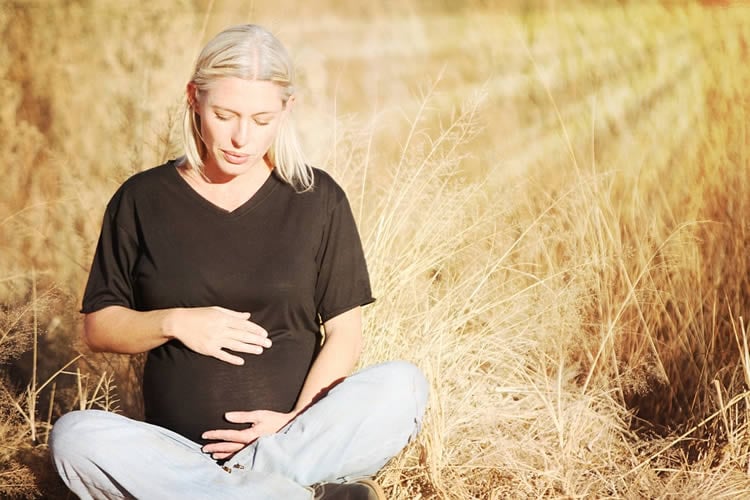Summary: According to researchers, babies whose mothers were more anxious spent longer focusing on environmental threats than those whose moms were more relaxed.
Source: Penn State.
Moms may be notorious worriers, but babies of anxious mothers may also spend more time focusing on threats in their environment, according to a team of researchers.
In a study, researchers used eye-tracking technology to measure how long babies spent looking at happy, neutral and angry faces. They found that the babies with anxious moms had a harder time looking away from an angry face — which they could view as a threat — than babies whose moms were not anxious.
Koraly Pérez-Edgar, professor of psychology at Penn State, said the findings — recently published in the journal Emotion — could help give clues about which children are at risk for developing anxiety later in life.
“Once we learn more about the pathways to anxiety, we can better predict who’s at risk and hopefully help prevent them from needing treatment later on,” Pérez-Edgar said. “Treatment is difficult for the child and parent, it’s expensive and it doesn’t always work. If we can prevent anxiety from developing, that’s a whole lot better. Let’s find out which kids are at the highest risk and intervene.”
Previous research has found that focusing too much on threat could potentially increase anxiety, and some forms of therapy focus on turning attention away from threat as a way to lower anxiety.
“Paying too much attention to threat, even as infants, could possibly set up this cycle. The more you fixate on threat, the more opportunity you have to see the world as a threatening place, which could help lead to more anxiety,” Pérez-Edgar said. “Additionally, we think that risk factors in biology and potentially mom’s anxiety could also make that more likely.”
To examine the relationship between a mother’s anxiety and her baby’s attention to threat, a research team led by Pérez-Edgar; Kristin Buss, professor of psychology at Penn State; and Vanessa Lobue, assistant professor of psychology at Rutgers University, recruited 98 babies between the ages of 4 and 24 months.
The babies’ mothers answered questions about their anxiety levels, and the babies were placed in front of a screen that was equipped with an eye tracker — a strip that ran along the bottom of the monitor and followed the movement of the babies’ irises using infrared.
As each baby focused on the screen, their gaze was measured while happy, neutral and angry faces appeared one at a time. Once the baby was focused on a face, a second image was flashed in their peripheral vision to distract them.
“By the time you’re a few months old, a reflex develops where you’ll automatically turn and look if something pops up in your peripheral vision,” Pérez-Edgar said. “This became a conflict for the babies, because they were focused on the face but then had this reflex to turn and look.”
The researchers found that the more anxious a baby’s mother was, the more time her baby spent looking at the angry faces before turning to look at the image in their peripheral vision. This suggests that the babies with anxious moms had a harder time disengaging from a potential threat in their environment.

Additionally, the researchers found that the age of the baby did not matter. The babies with anxious moms spent a longer time looking at the angry face whether they were four or 24 months old, suggesting a potential genetic element.
“It doesn’t seem like the babies are learning to pay more attention to threat from their anxious moms. If that were true, the older babies might have more trouble turning away because they’ve been around their moms longer than the younger babies,” Pérez-Edgar said. “This seems to suggest that there may be a shared genetic or biological component.”
Pérez-Edgar said the results give powerful clues about where to keep looking to learn more about how anxiety develops in children. In a future study, Pérez-Edgar, Buss and Lobue will take a closer look at how mother’s anxiety affects babies over time, instead of at one instance.
Funding: The National Institute of Mental Health (grant R21 MH103627) supported this research.
Source: Katie Bohn – Penn State
Image Source: NeuroscienceNews.com image is in the public domain.
Original Research: Abstract for “Maternal anxiety predicts attentional bias towards threat in infancy” by Morales, Santiago; Brown, Kayla M.; Taber-Thomas, Bradley C.; LoBue, Vanessa; Buss, Kristin A.; & Pérez-Edgar, Koraly E. in Emotion. Published online August 2017 doi:10.1037/emo0000275
[cbtabs][cbtab title=”MLA”]Penn State “Anxious Moms May Give Clues About How Anxiety Develops.” NeuroscienceNews. NeuroscienceNews, 27 September 2017.
<https://neurosciencenews.com/maternal-anxiety-7595/>.[/cbtab][cbtab title=”APA”]Penn State (2017, September 27). Anxious Moms May Give Clues About How Anxiety Develops. NeuroscienceNews. Retrieved September 27, 2017 from https://neurosciencenews.com/maternal-anxiety-7595/[/cbtab][cbtab title=”Chicago”]Penn State “Anxious Moms May Give Clues About How Anxiety Develops.” https://neurosciencenews.com/maternal-anxiety-7595/ (accessed September 27, 2017).[/cbtab][/cbtabs]
Abstract
Maternal anxiety predicts attentional bias towards threat in infancy
Although cognitive theories of psychopathology suggest that attention bias toward threat plays a role in the etiology and maintenance of anxiety, there is relatively little evidence regarding individual differences in the earliest development of attention bias toward threat. The current study examines attention bias toward threat during its potential first emergence by evaluating the relations between attention bias and known risk factors of anxiety (i.e., temperamental negative affect and maternal anxiety). We measured attention bias to emotional faces in infants (N = 98; 57 male) ages 4 to 24 months during an attention disengagement eye-tracking paradigm. We hypothesized that (a) there would be an attentional bias toward threat in the full sample of infants, replicating previous studies; (b) attentional bias toward threat would be positively related to maternal anxiety; and (c) attention bias toward threat would be positively related to temperamental negative affect. Finally, (d) we explored the potential interaction between temperament and maternal anxiety in predicting attention bias toward threat. We found that attention bias to the affective faces did not change with age, and that bias was not related to temperament. However, attention bias to threat, but not attention bias to happy faces, was positively related to maternal anxiety, such that higher maternal anxiety predicted a larger attention bias for all infants. These findings provide support for attention bias as a putative early mechanism by which early markers of risk are associated with socioemotional development.
“Maternal anxiety predicts attentional bias towards threat in infancy” by Morales, Santiago; Brown, Kayla M.; Taber-Thomas, Bradley C.; LoBue, Vanessa; Buss, Kristin A.; & Pérez-Edgar, Koraly E. in Emotion. Published online August 2017 doi:10.1037/emo0000275






